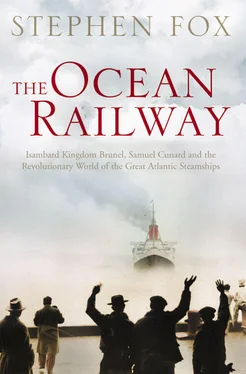In these circumstances of widespread chaos and hardship, of overcrowding, high prices, and temporary shacks, Abraham Cunard found and married a wife. Margaret Murphywas the daughter of Irish immigrants who had settled in South Carolina just before the war; her father joined the British forces and saw action in Georgia. The Murphys fled to Nova Scotia after the evacuation of Charleston in 1782. Abraham and Margaret were married on 22 June 1783; he was twenty-nine, she twenty-five. It was an odd match. The Murphys were Irish Catholics, had owned slaves in South Carolina, and did not share the pacifism, anti-slavery convictions, or abstemious habits of Quakers. This difficult marriage produced ten children over the next two decades. Samuel, the second child and oldest boy, was born on 21 November 1787, and named for his paternal grandfather.
Most of the Pennsylvania Loyalists settled in the new town of Shelburne, at the southern tip of Nova Scotia. Abraham Cunard – perhaps because of his rather heterodox marriage – instead went up to Halifax. The harbour town, less than forty years old, had been laid out on the slope of a steep hill that offered some protection from the northwest winter wind. Cunard found work as a foreman carpenter in the army’s timberyard at the docks. The Cunards lived near the water on Brunswick Street in the north end, a German section known as Dutchtown. Abraham and Margaret compromised their ancestral religious differences by joining an Anglican church. On his own time, Abraham bought vacant property and built houses for sale, turning good profits. He prospered enough to pay eight hundred pounds in cash, a substantial sum, for two waterfront land parcels in 1796 and 1798. He was also granted 1000 acres of timberland in northern Nova Scotia. At the yard he was promoted to master carpenter, earning nine shillings a day. As far as most outsiders could tell, the Cunards were doing well.
In private, the family was contending with an ongoing crisis caused by Margaret’s uncontrolled drinking. Years later, people told stories of her lying in the streets of Halifax, dead drunk, while her children went barefoot and sold produce from the family garden for a few coins. Abraham’s response is not known; his extended working hours, between his timberyard job and the houses he was building to sell, might have functioned as a refuge from his wife’s alcoholism – or perhaps a contributing factor to it. What seems clear is that Sam, as the oldest boy, had to assume early responsibilities. After a few years of grammar school, he started working for pay, wasting no time. Driving the cows home at night, he walked along knitting a bag to hold his money. He ran errands, picked dandelions and sold them at market, and purchased fish, potatoes and other goods at the wharves to sell door to door. At age fourteen he proudly bought a broadcloth suit, his first, with his own money.
Children from an alcoholic home may respond in wildly varying ways. In Sam Cunard’s case, he clamped a lifelong tight discipline on his emotions and pleasures. For a family of partly Quaker heritage, trying to make its way in a new and strange place, Margaret’s drinking was a shameful secret. But it could not really be kept hidden in a small town isolated by geography and circumstances. Gossips knew and talked about it. From this background, it seems, Sam developed his enduring habit of keeping himself under cover, of not giving public speeches or revealing much even in private letters. His own habits were notably ascetic; he associated heavy drinking with failure and embarrassment. When he later made such bald statements as ‘ I have neverknown an industrious sober man who has not succeeded’, he was referring obliquely to his mother’s losing struggle with rum.
From boyhood Sam toiled as a merchant, buying goods and selling them at a profit. He lacked the education for a professional career, like law or medicine, and had no taste for government or military positions, the other main avenues available to ambitious boys in Halifax. Living in a harbour town dominated by its waterfront commerce, he naturally turned to ships and shipping as the main medium for his business activities. On a typical working day he was up early and down to the docks, looking for deals, and finding them often enough to believe that his chosen field would reward hard effort and concentration. “ Tis truethat the merchant does not always succeed,’ Cunard later reflected, ‘ – but with patient industry he generally does – there is one thing certain that no one succeeds without application and close attention to the business he is intended for.’
He worked under his father, then with him, and quickly moved beyond him.
Abraham got him his first real job, as a clerk in the naval dockyard’s engineer department, and next arranged for him to spend a few years down in Boston, working in a shipbroker’s office and learning that business. By the age of twenty-one, in 1809, Sam had returned to Halifax and talked his father into founding the firm of A. Cunard & Son, ship agents and general merchants in the West Indian trade. On his own he also bought two parcels of wilderness land in the lightly settled northern reaches of Nova Scotia, a total of 5000 acres – the first of many distant land speculations he would try for their potential rents, timber or minerals.
The prolonged Napoleonic wars and, in particular, the War of 1812 between Great Britain and the United States brought flush times to Halifax. It became the main staging area and supply depot for British army and navy forces in America. At the same time, it continued doing business with those New England states that opposed the conflict. Within three months of the American declaration of war, Sam Cunard was granted a licence to import certain goods from the states: flour, meal, corn, pitch, tar and turpentine, all of them in turn useful for the naval war against the United States. Halifax seized the fortunate (if unprincipled) opportunity to supply both belligerents against each other. Privateering and smuggling also flourished, as captured ships and cargoes were auctioned off at low prices. ‘ As all aroundme are smuggling,’ one Nova Scotian decided, ‘I am beginning to smuggle too.’ Tobacco, soap and candles could be hidden in hogsheads and puncheons of codfish and then unpacked in a back room, out of sight. The Cunards probably joined in this lucrative, illicit, barely policed ™ the profits were hard to resist. By the end of the war they were buying and selling not just cargoes but the ships themselves.
The windfalls of war made Sam rich enough to take a wife. On 4 February 1815, at the age of twenty-seven he married Susan Duffus, seven years his junior. She was the daughter of a dry goods merchant and tailor who had come to Halifax from Scotland as a young man. Sam settled his bride in a fine new house at 21 Brunswick Street, adjacent to the home of his parents. His changed circumstances, upwardly striving and soon to include children, pushed Sam into taking a definite step, both merciful and ruthless, about his poor, sodden mother.
In late June 1815, with Susan three months pregnant, he bought farmland out in Hants County, at Pleasant Valley. He had a house built (a better home than most in that area, including a butler’s pantry and a central chimney with four fireplaces) and sent his mother to live there, near some of her Murphy relatives. Perhaps, with their first child soon to arrive, Sam and Susan did not want the addled grandmother right next door, visiting and possibly endangering the baby. Sam added more land to the property a few weeks after his son Edward was born. According to the local folklore that persisted in Hants County even into the 1950s, Margaret Cunard was dispatched in order to control her rum supply and to limit social embarrassments in Halifax. She was, significantly, banished without her husband – but with, it seems, his willing assent. Abraham kept working as a master carpenter at the timberyard, too far from Pleasant Valley for commuting fifty miles a day on horseback. After Margaret died in 1821, he finally retired in his late sixties and went out to live alone in her house.
Читать дальше












